The Glenfinnan Viaduct is one of Scotland’s most photographed landmarks. Whether you know it from the Harry Potter films, postcard views of trains curving through lush valleys or the tale of Victorian engineering ingenuity, this soaring concrete bridge never fails to impress. Built at the head of Loch Shiel on the West Highland Line, the viaduct’s 21 arches carry rail travellers above the River Finnan and provide a magnificent backdrop for the Jacobite Steam Train, a vintage service that operates each summer.
This guide is our will answer every question about Glenfinnan Viaduct, whether you plan to ride the train, watch it from a hillside, learn history of Glenfinnan Viaduct or experience surrounding area. It includes up‑to‑date schedules for 2025 Jacobite Steam Train, insider tips on where to park and stand, the story behind the nearby Glenfinnan Monument, and context on how the bridge was built.
Jump to Section
What and Where Is Glenfinnan Viaduct?
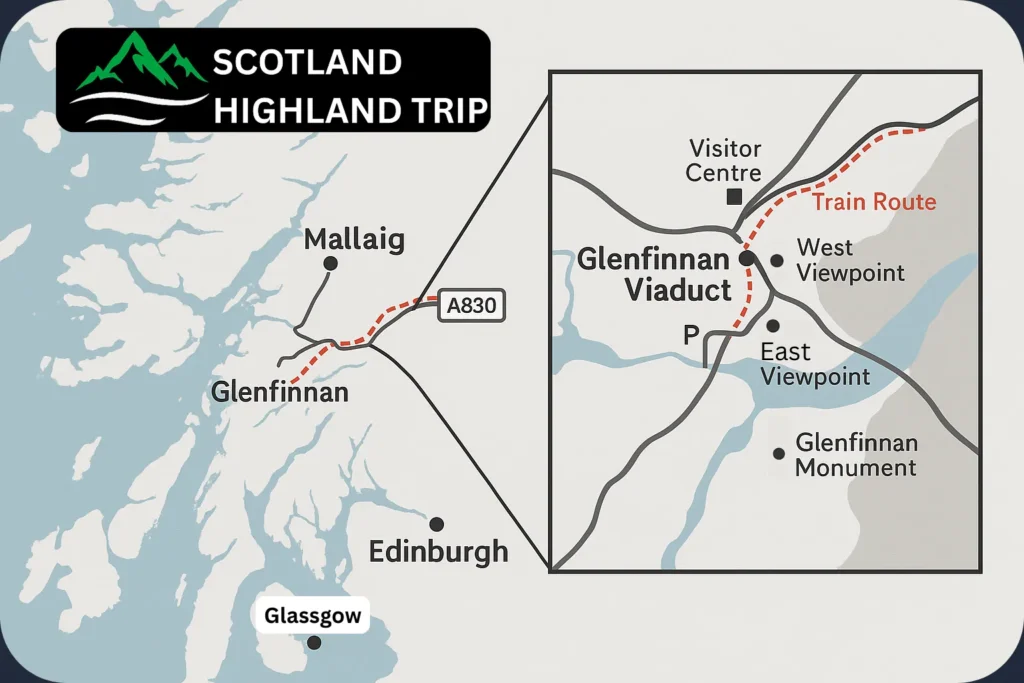
Glenfinnan Viaduct is a concrete railway bridge on the West Highland Line between Fort William and Mallaig. It stands near the hamlet of Glenfinnan in the Lochaber district of the western Highlands and sits at the north‑eastern end of Loch Shiel. Coordinates on the National Grid place the viaduct at roughly 56° 52 ′ 35 ″ N, 5° 25 ′ 55 ″ W. From Fort William it is about 17 miles (27 km) west along the A830 Road to the Isles.
Getting there:
- By car: The drive from Fort William takes around 30 minutes. From Glencoe it is roughly 55 minutes, from Oban 1.5 hours, from the Isle of Skye (Portree) 2.5 hours and from Edinburgh about 3.5 hours. The route follows scenic single‑carriageway roads; take care with sheep and slow vehicles.
- By train: ScotRail trains on the West Highland Line run year‑round between Glasgow Queen Street and Mallaig, stopping at Glenfinnan Station. From the station it is a 20 – 30 minute walk to the visitor centre and viaduct viewpoints.
- By bus: Local buses run from Fort William and drop passengers near the visitor centre. A car‑free visit is encouraged because the parking areas are limited (see below).
Parking is Limited, Arrive Early: Both official car parks combined hold around 150 cars and fill up fast on steam train days. Plan to arrive at least 45 – 60 minutes before train crossing.
History and Construction – A Victorian Concrete Marvel
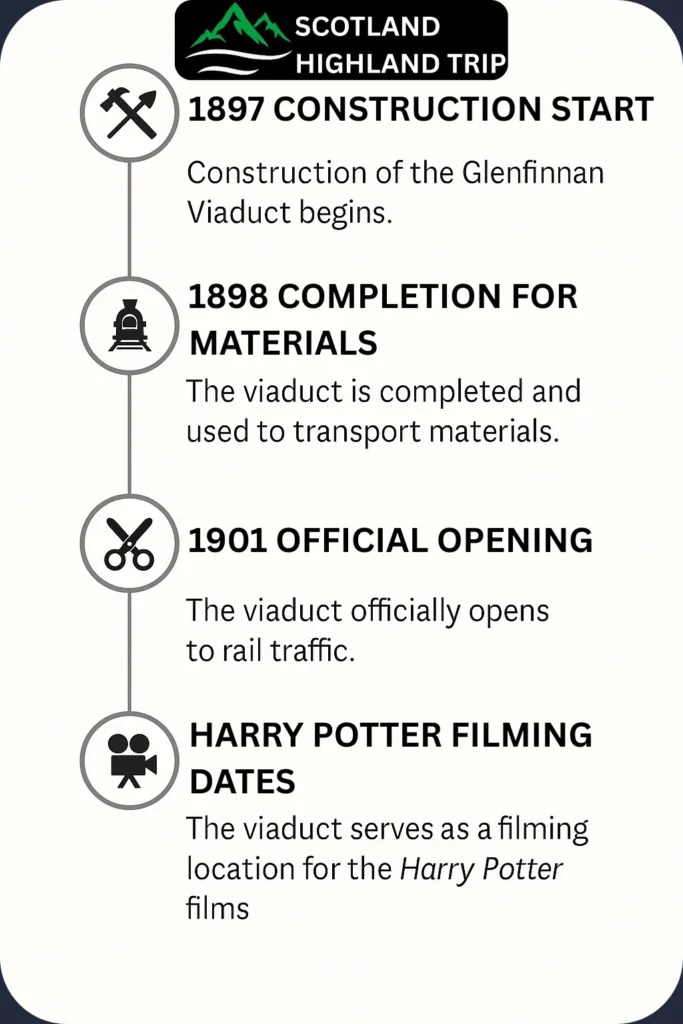
Origins
The West Highland Railway reached Fort William in the 1890s but needed a coastal extension to reach the fishing port of Mallaig. The extension’s signature structure would cross the steep River Finnan valley near Glenfinnan. Civil engineering firm Simpson & Wilson designed a viaduct of 21 semicircular arches, each 50 feet (15 m) across, built from mass concrete. Mass concrete was unusual in the 1890s because it lacked metal reinforcement, relying instead on the material’s compressive strength. The contractors Robert McAlpine & Sons, led by Robert McAlpine, nicknamed “Concrete Bob” began work in 1897. His sons Robert and Malcolm oversaw construction.
Do you know: Glenfinnan was one of the earliest large scale uses of mass concrete in railway viaducts with no steel reinforcement making it a pioneering structure for its time.
Building the Viaduct
Construction moved quickly. Work on the Mallaig extension started in January 1897, and the viaduct was ready to carry materials by October 1898. The entire extension opened on 1 April 1901. Glenfinnan Viaduct cost £18,904 at the time, a substantial sum but modest considering the scale and remote location. A myth that a horse and cart fell into one of the piers during construction persisted for decades; modern investigations in 2001 located the remains at nearby Loch nan Uamh Viaduct instead.
Design Features
- Length and height: The viaduct is 416 yards (381 m) long and 100 feet (30 m) high. It is Scotland’s longest concrete railway bridge and crosses the River Finnan.
- Arches: Twenty‑one semi‑circular spans of 50 feet (15 m) each.
- Curve: Built on a gentle curve with a radius of roughly 792 feet (241 m). The curvature adds visual drama and allows trains to transition smoothly from the valley onto the hillside.
- Material: Mass concrete poured into wooden formwork. The deck is 18 feet (5.5 m) wide between parapets, carrying a single‑track line.
Later History
The viaduct has carried passenger and freight trains for more than a century. Today, ScotRail diesel multiple units connect Glasgow to Mallaig year‑round. During spring and summer the line also hosts the Jacobite Steam Train (discussed below) and luxury trains like the Royal Scotsman. The bridge gained global fame after appearing as the Hogwarts Express route in the Harry Potter films. Its depiction on the Bank of Scotland’s £10 note attests to its status as an engineering icon.
Glenfinnan Monument and the Jacobite Rising
The valley around the viaduct witnessed an earlier episode of Scottish history. On 19 August 1745, Prince Charles Edward Stuart (Bonnie Prince Charlie) raised his royal standard at Glenfinnan and rallied around 1,200 Highlanders to begin the Jacobite Rising. The rebels hoped to restore the House of Stuart to the British throne. Although the uprising ultimately failed at Culloden, the site remains sacred to supporters of the cause.
To commemorate the fallen clansmen, an 18 m (59 ft) tower known as the Glenfinnan Monument was erected on the shore of Loch Shiel in 1815. A lone Highlander statue stands atop the column; visitors can climb the spiral staircase for a sweeping view of the loch. The National Trust for Scotland (NTS) manages the monument, visitor centre and cafe. Interpretive displays explain the 1745 Rising and local clan culture.
Opening hours typically run from 09:30 – 17:00 for the visitor centre and 11:00 – 12:30 and 13:30 – 16:00 for monument access. Entry costs around £5 for adults, and the car park fee is also £5. Parking is limited, so arrive early and consider taking public transport.
The Jacobite Steam Train (2025 Schedule and How to See It)
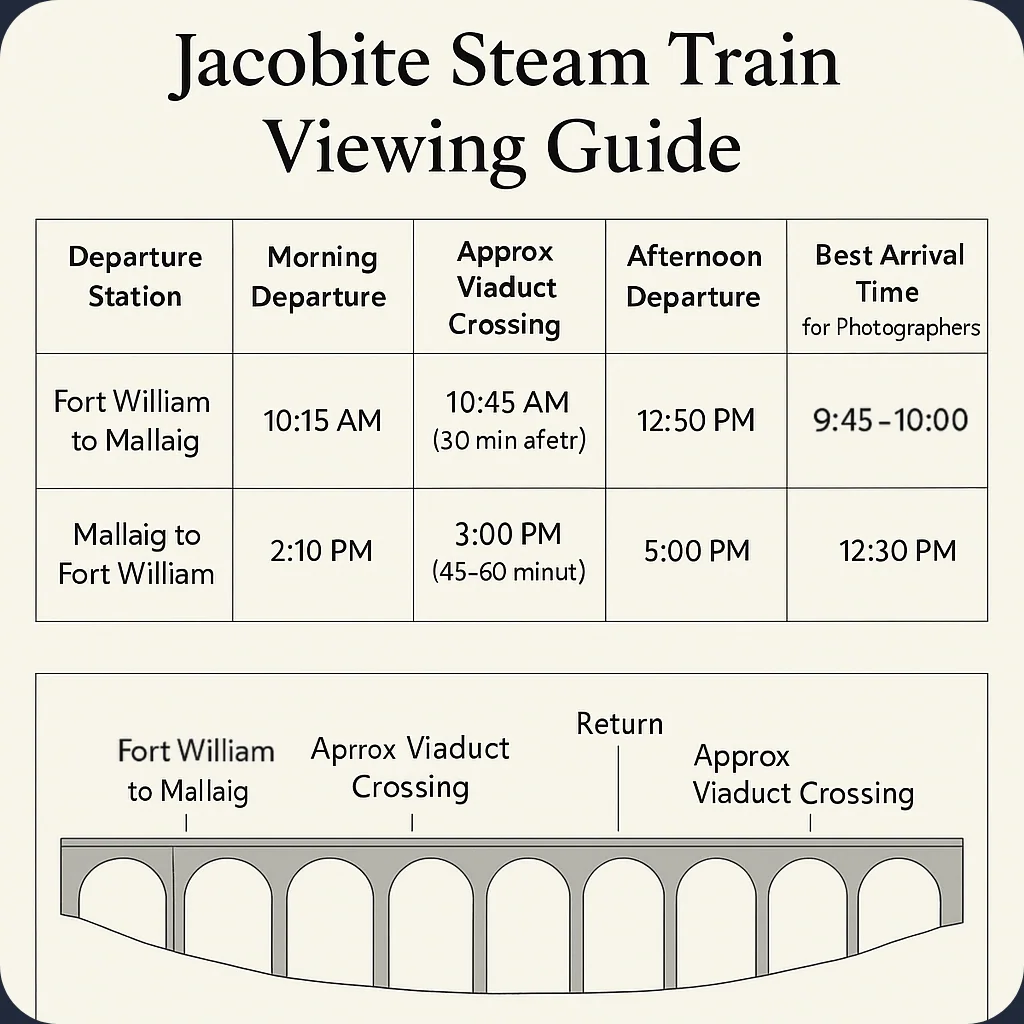
What Is the Jacobite Steam Train?
A vintage steam service began running over the West Highland Line in 1984 to promote tourism. It later adopted the historic moniker The Jacobite and today uses former British Rail locomotives and classic carriages. The train travels the 41‑mile (66 km) route between Fort William and Mallaig, crossing Glenfinnan Viaduct in both directions. Because its black locomotive and crimson coaches were used as the Hogwarts Express in the Harry Potter movies, the train attracts fans worldwide.
2025 Season and Departure Times
According to West Coast Railways and travel writers, the 2025 Jacobite season operates daily from 7 April – 24 October for the morning service and from 5 May – 26 September for both morning and afternoon services. Departure times are:
| Departure station | Morning service departure | Approx. viaduct crossing | Afternoon service departure | Approx. viaduct crossing |
|---|---|---|---|---|
| Fort William to Mallaig | 10:15 AM | 10:45 AM (30 mins after departure) | 12:50 PM | 1:20 PM (30 mins after departure) |
| Mallaig to Fort William | 2:10 PM | 3:00 PM (45 – 60 mins after departure) | 5:00 PM | 5:55 PM (45 – 60 mins after departure) |
These times are approximate, delays of 10 – 15 minutes are common. The exact crossing times are posted daily at the Glenfinnan Visitor Centre. Always check the official timetable before travelling.
Book Early: Jacobite Steam Train tickets can sell out in advance during summer. Reserve online through the official West Coast Railways website.
Best Places to Watch the Train
Photographers and trainspotters flock to hillocks overlooking the viaduct. There are two main viewpoints:
West viewpoint (train travelling west towards Mallaig). Start at the visitor centre car park and follow the Viaduct Trail along the River Finnan, passing under the viaduct. After about 15 minutes, turn left and climb a hill. You will enjoy a classic view with the train facing you.
- West Viewpoint GPS: 56.8765° N, 5.4345° W
East viewpoint (train returning from Mallaig). Follow the same trail but turn right after passing under the viaduct and climb the opposite hill. The train will be travelling away from you but the backdrop of Loch Shiel and the monument is spectacular.
- East Viewpoint GPS: 56.8768° N, 5.4315° W
When to Arrive and Parking Tips

- Morning train: Arrive at the car park by 09:45 – 10:00 AM to secure a space and hike to the viewpoint before the train passes around 10:45 AM. Allow 45 – 60 minutes for parking and walking.
- Afternoon train: Arrive by 12:30 PM to prepare for the 1:20 PM crossing.
- Evening returns: The return crossings around 3:10 – 3:25 PM and 6:05 – 6:15 PM provide alternative viewing times. Note that the train faces away from the western viewpoint when returning.
Walking Time: Allow 15 – 20 minutes from car park to hill viewpoint.
Parking is limited to two adjoining car parks near the visitor centre. The National Trust car park holds about 55 cars and costs £5 (free for NTS members). The adjacent community car park, built in 2021, holds around 100 vehicles and also charges £5. If both are full, you may need to park at a lay‑by farther down the A830 and walk 30 minutes. Parking on the road verge near the visitor centre is forbidden. Alternatively, avoid parking altogether by taking the train or bus and using the signposted trails.
Safety and Etiquette
- Stay off the railway line. The viaduct is an active railway, and walking on it is illegal and dangerous. British Transport Police have warned fans to keep off the track.
Wear suitable footwear and clothing. Paths can be muddy and slippery. Bring a waterproof jacket, Highland weather changes quickly. - Respect private land and wildlife. Follow the Scottish Outdoor Access Code, stick to marked trails, and avoid disturbing livestock.
- Keep drones grounded. Drone use is restricted near the viaduct and visitor centre (check local regulations).
Important: Trespassing on the viaduct can result in fines up to £1,000 and is extremely dangerous.
Best Viewpoints and Walking Routes
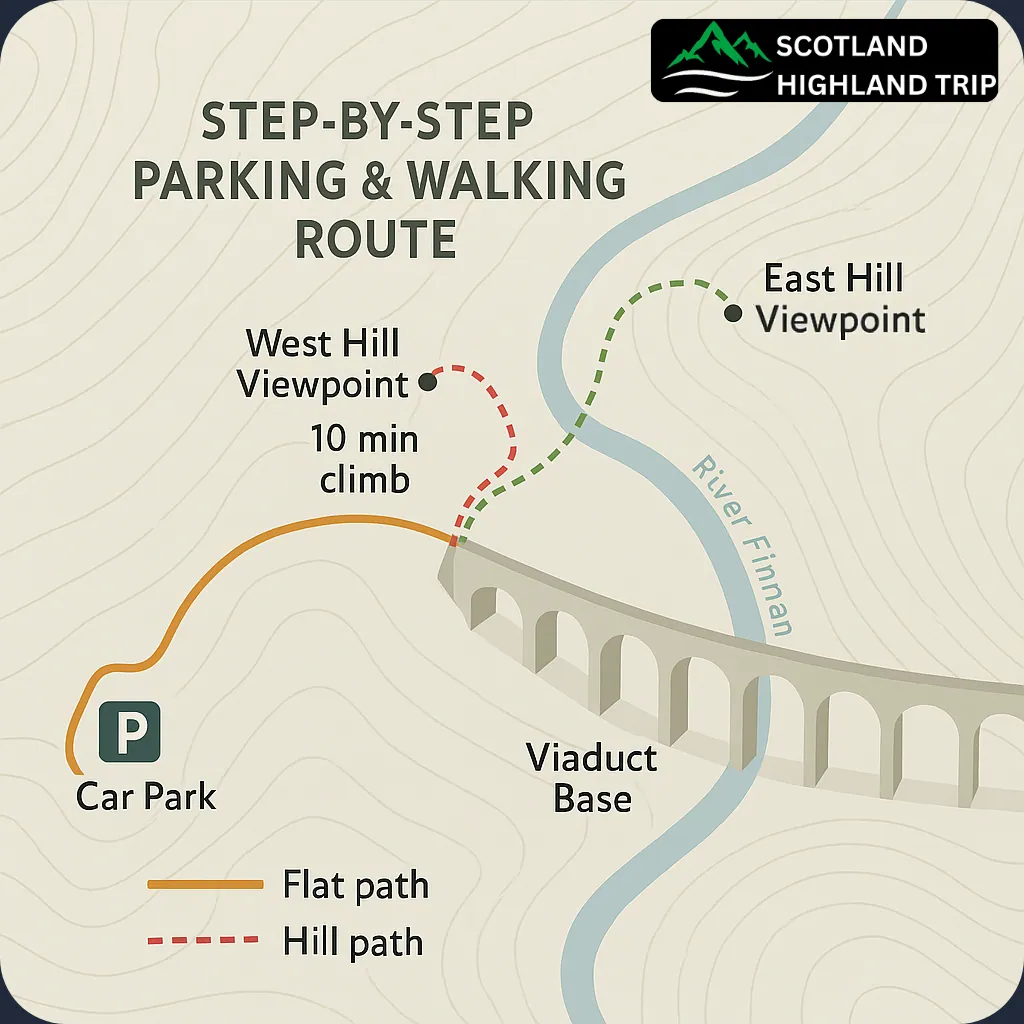
The National Trust for Scotland outlines several routes to view the viaduct:
- Close‑up views: A 15‑minute flat path beside the River Finnan from the car parks leads to the viaduct’s base, accessible for wheelchairs and pushchairs. To see it from above, add a 10‑minute climb up a hillside path with steps.
- Train platform view: Walk 15 minutes from the car park to Glenfinnan Station to watch the train arrive and depart. You cannot stand on the viaduct itself.
- 360° panorama: A 5‑minute climb to the viewpoint above the visitor centre offers a broader panorama of the viaduct, Loch Shiel, the monument and surrounding peaks.
- Circular trail: Combine the above paths into a 4 km loop (60 – 90 minutes) featuring various vistas; some sections are steep and may be slippery.
- Car‑free trail: For an eco‑friendly outing, ride the ScotRail train from Fort William to Glenfinnan. From the station, a 1.5 mile (2.4 km) path crosses the hillside to the viaduct and visitor centre; allow 45 minutes. NTS offers 2‑for‑1 tickets to climb the monument for visitors arriving by train.
Monument View GPS: 56.8735° N, 5.4311° W – Great for capturing viaduct, Loch Shiel, and surrounding peaks in one frame.
Best Photo Spot in Glenfinnan Viaduct
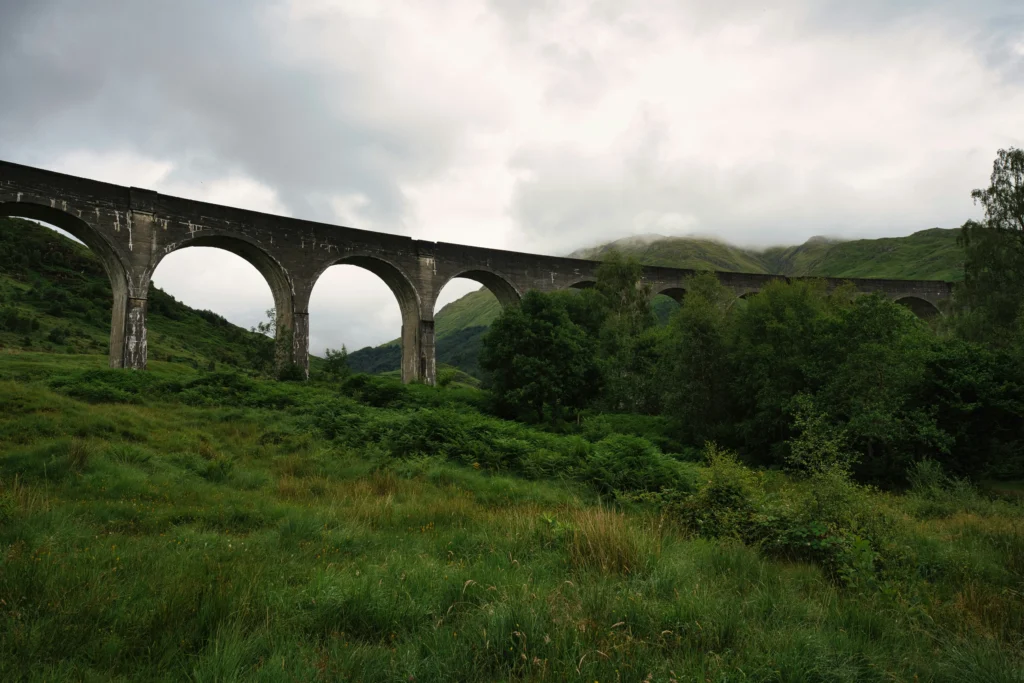
If you have seen the Glenfinnan Viaduct in photographs and wondered where those perfect shots were take. After years of guiding tours here, Our team has tested every angle and there are two main viewpoints that capture the best.
1. West Hill Viewpoint (The Classic Harry Potter Shot)
This is the view everyone recognises: the Jacobite Steam Train curving across the viaduct, steam trailing into the Highland sky.
- How to get there: From the visitor centre car park, follow the Viaduct Trail along the River Finnan. Go underneath viaduct, take left path uphill.
- Why it is the best: When the train is heading west towards Mallaig, it faces directly towards this hillside, giving the iconic head-on shot.
- Tip: Arrive 45 to 60 minutes before train crossing so you have time to park, walk up and secure a front row spot.
2. East Hill Viewpoint (Loch Shiel in the Background)

This angle captures the train heading east, with the Glenfinnan Monument and Loch Shiel behind it.
- How to get there: Take the same path under viaduct but turn right and climb the opposite hill.
- Why it is worth it: The loch and monument add depth and history to your shot, perfect for a more scenic composition.
- Tip: Best for the train return from Mallaig in the afternoon.
Emma’s Advice:
“I always tell our tour guests to do both viewpoints if they can. The west hill gives the powerful Harry Potter moment, while the east hill shows viaduct as part of the wider Highland story. Bring zoom lens if you have one, and remember rain, mist or sun, the photos here are always amazing.”
Nearby Attractions and Things to Do
Even if you miss the steam train, Glenfinnan is worth exploring. Highlights include:
- Glenfinnan Visitor Centre: Exhibits on the Jacobite Rising, Highland clans and the viaduct. The on‑site café serves hot drinks and light meals. Browse local crafts at the shop.
- Loch Shiel: Take a boat trip on this 20 mile (32 km) freshwater loch. The loch is a haven for wildlife, golden eagles, red deer, otters and even seabirds at its western end.
- Glenfinnan Church (St Mary’s and St Finnan’s): A Gothic‑style Catholic church from the 1870s overlooking Loch Shiel. The interior features intricate woodwork and memorials.
- Glenfinnan Station Museum: Located in the former station building, the small museum displays railway artefacts and tells the story of the West Highland Line.
- Hiking: Trails lead into the surrounding hills, such as the Corryhully Horseshoe for experienced hillwalkers. Nearby Loch Eilt and Loch Morag provide tranquil picnic spots.
Wildlife Spotting Tip: Early mornings are best for seeing golden eagles, late afternoons bring red deer view near the lochside.
Frequently Asked Questions
Where is the Glenfinnan Viaduct exactly?
It spans the River Finnan near the head of Loch Shiel in the Scottish Highlands. The hamlet of Glenfinnan lies nearby. By road it is about 17 miles west of Fort William and 30 minutes from there.
How many arches does the viaduct have?
Twenty‑one semi‑circular arches, each 50 feet wide.
When was the Glenfinnan Viaduct built?
Construction began in January 1897; the bridge was ready for traffic by October 1898 and formally opened on 1 April 1901.
Who built it?
The design was by engineers Simpson & Wilson, and the contractor was Robert McAlpine & Sons, known for pioneering mass concrete.
Why is it sometimes called the “Harry Potter bridge”?
The bridge appeared in several Harry Potter films as the route of the Hogwarts Express. Its curved profile and scenic surroundings made it a perfect cinematic backdrop.
What time does the Jacobite train cross the viaduct?
The morning train leaves Fort William at 10:15 AM and usually crosses the viaduct around 10:45 AM. The afternoon train leaves at 12:50 PM and crosses around 1:20 PM. Return crossings occur at approximately 3:00 PM and 5:55 PM. Arrive at least 45 minutes early for parking and the short hike to the viewpoint.
Is there parking at Glenfinnan?
Yes two pay‑and‑display car parks next to the visitor centre hold around 150 vehicles combined. The fee is £5 per day. They fill quickly, so arrive early. Do not park on roadside verges.
What’s the best viewpoint?
Most photographers choose the west hillside (left turn after passing under the viaduct) because the train faces them when travelling from Fort William. The east hillside gives an alternate view when the train returns.
Can you walk on the viaduct?
No. It is an active railway line and trespassing is illegal and dangerous. Use designated trails and viewpoints.
How long is the walk to the viewpoint?
Around 15–20 minutes from the visitor centre. Paths can be uneven and muddy, so wear sturdy footwear.
Is the viaduct still used by regular trains?
Yes, ScotRail services operate year‑round, and luxury trains like the Royal Scotsman occasionally cross.
What happens if I miss the train?
Enjoy the scenery! Visit the museum and monument, walk down to Loch Shiel, or relax at the café. The viaduct is photogenic even without a steam engine.
Emma’s Favourite Glenfinnan Moment

“I have taken many tours across the Isles, but Glenfinnan is still my favourite,” Said Emma Taylor, our lead Highland guide. “One June morning, we got there early. Soft mist covered the heather, and the only sounds were the river below and a cuckoo bird calling far away. As we walked up the hill, I heard the gentle puff-puff of a train. Then, all of a sudden, the Jacobite train came into view, steam curling out like a slow cloud.
The passengers waved, we waved back and cheered, and for a moment it felt like history, machines, and movie magic all came together. Then the valley went quiet again. That’s the magic of Glenfinnan, a quick, beautiful moment in the heart of the Highlands.”
Travel Tips and Responsible Visiting
- Check forecasts: Highland weather changes rapidly. Bring layers, waterproofs and sunscreen with.
- Travel off peak: Try Visiting outside July – August to avoid crowd. Early spring and late autumn offer quieter experiences with beautiful light.
- Support local: Stop at Glenfinnan cafés and shops, or stay overnight at local B&Bs. Respect residents and livestock.
- Leave no trace: Carry all litter, stick to paths and avoid disturbing wildlife. The landscape is fragile and deserves full care.
Best Season Tip: Visit in May – June or September for fewer crowds, longer daylight, and blooming heather around the viaduct.
Disclaimer: The information of this guide is based on sources accurate at the time of writing, including official timetables, visitor centre resources, and local travel advice. Train schedules, opening hours, ticket prices, and access conditions may change without notice. Always check directly with operators before planning and booking.

Emma is a solo traveler and freelance travel writer from New Zealand who spent three weeks exploring the Scottish Highlands. With a deep appreciation for history and landscapes, she booked a series of day tours and a private chauffeur journey with Scotland Highland Trip. From Loch Ness to the Cairngorms, she documented her experience through vivid blog posts and drone footage.







2 Comments
Your comment is awaiting moderation.
Hello to every one, it’s really a fastidious for me to pay a visit this website,
it contains helpful Information.
Here is my homepage … just kill pro
Your comment is awaiting moderation.
Unquestionably believe that which you stated. Your favorite
reason seemed to be on the internet the simplest thing to be aware of.
I say to you, I certainly get irked while people consider
worries that they just don’t know about. You managed
to hit the nail upon the top as well as defined out the whole thing without having side-effects , people could
take a signal. Will probably be back to get more.
Thanks
Take a look at my website; justkill
Your comment is awaiting moderation.
Have you ever considered about including a little bit more than just your
articles? I mean, what you say is important and all.
Nevertheless think of if you added some great photos or video clips to
give your posts more, “pop”! Your content is excellent but with images and videos, this blog could undeniably be
one of the best in its niche. Excellent blog!
Feel free to visit my site – savastan0 cc
Your comment is awaiting moderation.
I feel that is among the such a lot significant info for me.
And i am glad studying your article. But want to remark on few normal things,
The website taste is perfect, the articles is actually excellent : D.
Excellent task, cheers
Review my page savastan0. cc
Your comment is awaiting moderation.
I visited several web pages however the audio feature
for audio songs existing at this web site is really wonderful.
My webpage; savastan cc
Your comment is awaiting moderation.
Hey there! I know this is kind of off topic but
I was wondering which blog platform are you using for this website?
I’m getting tired of WordPress because I’ve had
problems with hackers and I’m looking at alternatives for another platform.
I would be great if you could point me in the direction of a good platform.
Also visit my homepage savastan cc
Your comment is awaiting moderation.
Hey I am so happy I found your web site, I really found you by accident,
while I was looking on Bing for something else, Regardless I am here now and
would just like to say cheers for a fantastic post and a all round interesting blog (I also love the theme/design), I
don’t have time to look over it all at the minute but I
have saved it and also added in your RSS feeds, so when I have
time I will be back to read much more, Please do keep up the
awesome job.
Feel free to surf to my web site; savastan
Your comment is awaiting moderation.
It’s very trouble-free to find out any topic on web
as compared to books, as I found this post at this website.
Take a look at my website … savastan0.tools
Your comment is awaiting moderation.
Wow, this article is nice, my sister is analyzing such things, therefore I am going to tell her.
Have a look at my blog post; savastan0.tools
[…] throughout this guide. Rail passes and advance tickets can save money. To reach remote places like Glenfinnan or Cairngorms, change to Glasgow or […]
Your comment is awaiting moderation.
Hey There. I found your blog using msn. This is a very well written article.
I will make sure to bookmark it and return to read more of your useful information. Thanks for the post.
I will definitely return.
Check out my webpage – savastan0. cc
[…] Inverness might be small, but it sits at the heart of the Scottish Highlands and punches above its weight for things to do in inverness and see. Often called the Capital of the Highlands, the city stands at the mouth of the River Ness and is a natural base for exploring the north. It’s also a major transport hub: trains and buses connect Inverness with Edinburgh, Glasgow, Fort William and beyond, and its compact centre is easy to explore on foot. Whether you have a day or a week, use this guide to discover the best attractions in the city, ideas for car‑free travel and unforgettable day trips to Loch Ness, Culloden Battlefield and even the Glenfinnan Viaduct. […]